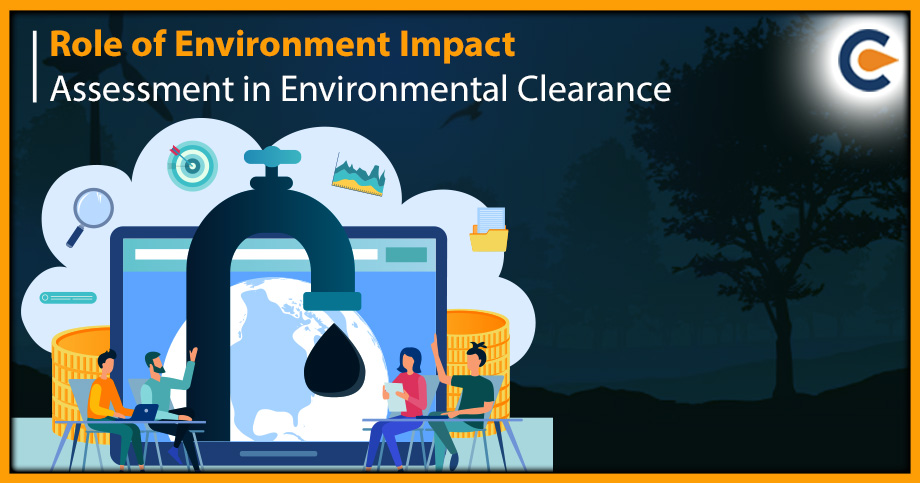The process for obtaining government approval for the installation and modification (amendment) of specific projects is known as the environmental clearance process. It is necessary for initiatives with a high potential for environmental pollution. Through a notification issued in accordance with the requirements of the Environment (Protection) Act of 1986, the Ministry of Environment & Forests has made Environmental Clearance (EC) mandatory in some instances. The EIA Notification of 2006, includes a total of 39 activities including infrastructure, thermal power plants, mining, etc. The MoEF[1] released a revised notification on the Environmental Clearance procedure in September 2006 and modified it in December 2009 in light of extensive experience with the EC process as well as the needs of interested parties.
Need for EIA in Environmental Clearance
According to the described methods, an EIA must give a detailed assessment of the state of the current environment, the strains caused by various activities, and the effects these will have on various environmental components. The developers of the initiatives must also propose and give countermeasures to the negative impacts. Due to the ecological crisis that a development activity can have, managers and decision-makers around the world are now highly concerned. The concerns of nodal agencies are centred on supporting sustainable development and preventing activities that negatively influence the living conditions of people, animals, plants, and the physical environment.
EIAs are conducted in various industries, including forestry, mining, tourism, manufacturing, and agriculture. A hydroelectric dam is an example of a huge project that needs an EIA. Another example is a new hotel on a beach. However, when deciding whether an EIA is necessary as the impact on human and environmental health rather than the project’s size, matters most.
Components of Environment Impact Assessment
The following environmental elements are examined throughout the EIA process.
- Environmental air
- Air quality outside.
- Wind direction, humidity,
- Probable project emission volume.
- Emission’s effects on the locality.
- Goals of pollution control and requirements for air quality.
- Noise
- levels of current and anticipated noise
- Approaches to lessen noise pollution.
- Environmental water
- The quality and quantity of the zone’s surface and groundwater resources.
- A project’s potential impact on water resources.
- Biological setting
- Animals and plants in the impact zone.
- Possible harm (likely) caused by the project, including emissions, effluents, and landscaping.
Stage in Assessment Process during Environmental Clearance
EIA involves the steps mentioned below. However, the EIA process is cyclical with the interaction between the various steps.
Stage 1: Screening: The project plan is examined to determine the investment amount, the development’s type and location and whether statutory approval is required.
Stage 2: Scope: The project’s possible effects, impact zone, the potential for mitigation, and requirement for monitoring. EIA methods include inventory analysis, hazard likelihood, and hazard index.
Stage 3: Making a decision: The Impact Assessment Authority consults the project manager and the consultant before making the final choice, considering the EIA and EMP (Environment Management Plan).
Stage 4: EMP implementation and monitoring: The project’s various phases of execution are closely watched. Potential alternatives should be identified for every project, and environmental features should be examined. Assessment of Alternatives, Delineation of Mitigation Measures, and Environmental Impact Assessment Report. Both project site and process technologies should be considered as alternatives.
The objective of the Assessment Process in Environmental Clearance
- EIA seeks to anticipate environmental effects early in the project planning and design process, identify strategies for minimising negative effects, adapt projects to the local environment, and give predictions and options to decision-makers.
- Both the positive and negative effects of the project are methodically examined by the EIA, which ensures that these effects are considered throughout the project design.
- EIA aids in identifying potential environmental effects of the project under consideration, suggest ways to lessen adverse effects, and forecasts whether there will be significant negative ecological effects even after mitigation measures are put in place.
- The environmental assessment offers various advantages, including protecting the environment, maximising resource utilisation, and reducing project time and expense by taking into account the environmental effects and their mitigation early on in the project planning cycle.
- By encouraging community involvement, educating decision-makers, and assisting in establishing environmentally healthy projects, an EIA that has been properly completed also lowers conflicts. The integration of EIA has been shown to offer advantages at every step of a project, from exploration and planning to build, operations, decommissioning, and beyond site closure.
- Positive and negative, reversible and irreversible, and temporary and permanent impacts must be projected, and this requires the assessment agency to have a thorough grasp of the project. Baseline information refers to the study area’s environmental conditions that must be adhered to.
- The EIA report should include activities and methods for preventing, limiting, or bypassing the impacts, or the amount of compensation for likely environmental loss or damage.
Essential Components EIA under Environmental Clearance
- An EIA should make it possible for decision-makers to comprehend the effects of a project at every stage. Additionally, it needs to give the general public and other interested parties a chance to voice their opinions about planned growth.
- An EIA must also contribute to and enhance the project design so that environmental and socioeconomic factors are central to it to be genuinely effective.
- The information must be supported by reliable statistics, organised according to acknowledged standards and clear enough for decision-makers to grasp.
- During project operations and construction, it is crucial to adhere to the approved procedures and designs, and continuing monitoring must be in place for the project’s duration.
- After the alternatives have been examined, the chosen option should create a mitigation plan and an Environmental Management Plan (EMP) to direct the proponent towards environmental improvements.
- After the EIA report is finished, the general public and environmental organisations with members who live close to the project site may be notified and consulted.
Assessments related to Environmental Clearance
EIA is just one sort of environmental evaluation that is used to find and reduce projects’ negative environmental effects. Integrated Environmental Assessments (EAs) and Strategic Environmental Assessments (SEAs) are two examples of these.
- Environmental Assessments (EAs), also known as Strategic Environmental Assessments (SEAs): An SEA is a systematic decision-making procedure used to assess the consequences of proposed development activity on the environment and human health. Before the environmental impact assessment, this procedure establishes the scope, level of study, and methods of public involvement and engagement that will be incorporated into the plan. Wherever possible, the EA process should include public engagement and consultation, which are crucial components (United Nations, 2012).
- Integrated environmental assessments (IEAs): An IEA is a procedure for creating and disseminating information on significant interactions between the natural environment and particular human activities that is future-oriented and useful for policy (IISD & UNEP, 2008). EIAs are the most often used environmental assessments compared to SEAs and IEAs. It is crucial to emphasise that all EIAs are grounded in the principles of sustainable development and that they all work to protect the environment and natural resources for future generations by providing information on how human development will proceed and possible mitigation measures.
Stakeholders in the EIA Process
Those who propose the project
- Central and State Pollution Control Boards
- The environmental expert who creates the EIA on the project’s behalf
- The Impact Assessment Agency
- Public
- The regional centre of the MoEF&CC
Applying for Environmental Clearance
- One must apply for environmental clearance as part of the Phase I Environmental Site Assessment. The notification’s required Form 1 must be used to submit an implementation for an EC.
- This must be completed before the applicant starts any construction work or site preparation. Pre-feasibility report copies must be included with the application. EC for an infrastructure project may take up to 12 months or more. During the PPP project cycle, project sponsors should budget for this time.
- Regarding the EC, some approval for the initiatives is required from the participating State Governments where the initiatives exist, such as Consent under the Water and Air Acts. This can be carried out concurrently and typically takes less time than the EC procedure.
Documents required for Environmental Clearance
Form 1 of the EIA Notification for Phase I Environmental Site Assessment does not include any information on the needed information checklist.
Form 1 does not require any information.
- Project information in general (name, location etc.)
- Details of the project-related activity:
- local physical alterations brought induced by actions
- the project’s usage of natural resources
- objects or substances that could be toxic or hazardous.
- Creation of solid waste
- Air, land, and waterways have been contaminated.
- Light and heat emissions, as well as noise and vibration creation
- accident danger
- Potentially accumulative or consequential factors
- Information on the project site’s proximity to environmentally sensitive areas
- Proposed EIA study terms of reference
- The competent regulatory body receives the application for EC.
EIA Final Report
- a film or CD with a copy of the public hearing proceedings (where public consultations are mandatory)
- duplicate of the completed floor plan
- a replica of the project’s feasibility report
Conclusion
A project’s potential risks to the environment and human well-being must be identified, along with steps that can be taken to remove or at least reduce such risks. In such cases, Environmental clearance comes into play. An efficient EIA activity is focused, time- and cost-bound, and it clarifies the evaluation. The development project’s construction and implementation have as their main goal the eradication of environmental degradation. The wider public and those in the project’s immediate area and neighbourhood should also be considered. Only when the public is aware of individuals in charge of upholding environmental quality and enforcement and the EIA report and the data it contains, can be evaluated.
Read our Article:Environmental Clearance Process In India: A Complete Outlook











